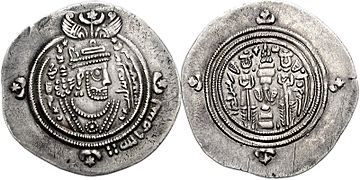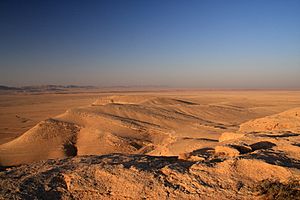Yazid I facts for kids
Quick facts for kids Yazid Iيزيد بن معاوية |
|||||
|---|---|---|---|---|---|
| Khalīfah | |||||

Arab-Sasanian dirham of Yazid I, struck at the Basra mint, dated AH 61 (AD/CE), the year in which the Battle of Karbala occurred
|
|||||
| 2nd Caliph of the Umayyad Caliphate | |||||
| Reign | April 680 – 11 November 683 | ||||
| Predecessor | Mu'awiya I | ||||
| Successor | Mu'awiya II | ||||
| Born | c. 646 (25 AH) Syria | ||||
| Died | 11 November 683 (aged c. 37) (14 Rabi al-Awwal 64 AH) Huwwarin, Syria |
||||
| Spouse |
|
||||
| Issue |
|
||||
|
|||||
| House | Sufyanid | ||||
| Dynasty | Umayyad | ||||
| Father | Mu'awiya I | ||||
| Mother | Maysun bint Bahdal | ||||
| Religion | Islam | ||||
Yazid ibn Mu'awiya ibn Abi Sufyan (Arabic: يزيد بن معاوية بن أبي سفيان, romanized: Yazīd ibn Muʿāwiya ibn ʾAbī Sufyān), known as Yazid I, was an important leader in early Islamic history. He was the second caliph of the Umayyad Caliphate, ruling from April 680 to November 683. A caliph was a leader of the Muslim community, acting as a religious and political ruler.
Yazid's rule was significant because he was the first caliph to inherit his position from his father. This was a new idea in Islamic history. His time as caliph saw some major events. These included the death of Muhammad's grandson, Husayn ibn Ali, and the start of a civil war called the Second Fitna.
Many people today, especially Shi'a Muslims, view Yazid as a bad ruler. This is mainly because of Husayn's death and his army's actions in other cities. However, some modern historians see him as a capable leader, though not as successful as his father.
Contents
Early Life and Family
Yazid was born in Bilad al-Sham, which is modern-day Syria. His birth year is thought to be around 646 CE. His father was Mu'awiya I, who later became the first Umayyad caliph. Yazid's family, the Umayyads, were an important clan from Mecca.
His mother, Maysun bint Bahdal, came from the powerful Banu Kalb tribe. She was a Christian, like many in her tribe. Yazid spent his childhood springs with his mother's family in the Syrian Desert. The rest of the year, he was with his father's court, which included Greek and Syrian officials.
Before becoming caliph, Yazid led military campaigns against the Byzantine Empire. These were attempts to expand the Caliphate's territory. Some sources say he was not eager to join these campaigns. However, other historical records suggest he led a large army and even besieged the Byzantine capital, Constantinople.
Becoming Caliph
The idea of Yazid becoming caliph was controversial. In early Islamic history, leaders were chosen by community support or by important companions of Muhammad. The position was not meant to be passed down from father to son.
Yazid's father, Mu'awiya I, wanted Yazid to be his successor. He worked hard to get support for Yazid. He gathered influential men from different regions to his capital, Damascus. He used flattery, gifts, and even threats to gain their support.
However, some important Muslim leaders in the Hejaz region (where Mecca and Medina are) opposed this. These included Husayn ibn Ali, Muhammad's grandson, and Abd Allah ibn al-Zubayr. They believed the caliph should be chosen by consultation, not by inheritance.
Mu'awiya tried to get these leaders to agree, but they refused. Despite their opposition, Mu'awiya managed to get most people to accept Yazid as the next caliph before he died.
Yazid's Reign
When Mu'awiya I died in April 680, Yazid became caliph. He was in Huwwarin, a town in the Syrian desert, at the time. His father had left him advice on how to rule. Mu'awiya warned him about Husayn and Ibn al-Zubayr, who might challenge his rule. He also advised Yazid to treat Husayn carefully because he was Muhammad's grandson.
Oaths of Allegiance
Yazid asked all provincial governors to pledge their loyalty to him. He specifically asked the governor of Medina to get oaths from Husayn and Ibn al-Zubayr.
Husayn and Ibn al-Zubayr refused to pledge allegiance to Yazid. They both left Medina for Mecca. Other important figures, however, did pledge their loyalty to Yazid.
The Battle of Karbala
In Mecca, Husayn received letters from people in Kufa, a city in Iraq. They invited him to lead a revolt against Yazid. Husayn sent his cousin, Muslim ibn Aqil, to Kufa to check the situation. Ibn Aqil reported that Husayn had strong support there.
However, Yazid replaced the governor of Kufa with a strict leader named Ubayd Allah ibn Ziyad. Ibn Ziyad quickly suppressed the revolt in Kufa and had Ibn Aqil executed.
Husayn, unaware of these events, continued his journey to Kufa. He ignored warnings from others not to go. Yazid's army blocked Husayn's entry into Kufa and forced him to camp in the desert of Karbala. After negotiations failed, a battle took place on October 10, 680. Husayn and 72 of his male companions were killed. His family members were taken prisoner. Yazid treated the captives well and sent them back to Medina.
Revolt of Abd Allah ibn al-Zubayr
After Husayn's death, Abd Allah ibn al-Zubayr became a major opponent of Yazid. He declared Yazid removed from power and secretly began to gather support for himself as the new caliph.
Yazid tried to make peace with Ibn al-Zubayr, but he refused. Yazid then sent an army to arrest him, but this attempt failed. The people of Medina were also unhappy with Yazid's rule. They accused him of living a lavish lifestyle. The Medinese leaders renounced their loyalty to Yazid and expelled his governor.
Yazid sent a large army to regain control of the Hejaz. This army defeated the Medinese in the Battle of al-Harra in August 683. The city of Medina was then sacked. After this, Yazid's army marched to Mecca and besieged the city. During the siege, the Ka'ba, a sacred Muslim shrine, caught fire. The siege ended when Yazid died suddenly in November 683. His army then returned to Syria.
Governance and Military
Yazid continued his father's way of ruling. He relied on provincial governors and local leaders. He kept many of his father's officials, including Ubayd Allah ibn Ziyad. Yazid also gave gifts to tribal leaders to gain their support.
His government and military were not highly centralized. Provinces kept most of their tax money and sent only a small part to the caliph. Military units were made up of local tribes.
Yazid focused on strengthening Syria's defenses against the Byzantine Empire. He created a new military district in northern Syria called Jund Qinnasrin. He also lowered taxes for the Christian community of Najran but removed a special tax exemption for the Samaritans.
In North Africa, Yazid reappointed Uqba ibn Nafi as governor. Uqba led a large expedition into western North Africa, reaching the Atlantic coast. However, he was later ambushed and killed, leading to the loss of these newly conquered areas. Yazid's death in 683 led to chaos in the eastern provinces, ending further military campaigns there.
Death and Succession
Yazid died on November 11, 683, in Huwwarin, Syria. He was between 35 and 43 years old. He was buried there.
After Yazid's death, Abd Allah ibn al-Zubayr declared himself caliph. He gained control over Iraq and Egypt. In Syria, Yazid's son, Mu'awiya II, became caliph. However, his rule was very limited. Mu'awiya II died after only a few months.
After Mu'awiya II's death, Yazid's family members tried to put his younger son, Khalid ibn Yazid, on the throne. But Khalid was considered too young. Instead, Marwan ibn al-Hakam became caliph in June 684. This change meant that Yazid's family line, known as the Sufyanids, was replaced by the Marwanid family within the Umayyad dynasty. By 692, Marwan's son, Abd al-Malik ibn Marwan, had defeated Ibn al-Zubayr and restored Umayyad power across the Caliphate.
Legacy and Different Views
The death of Muhammad's grandson, Husayn, caused great sadness and anger among Muslims. This event greatly damaged Yazid's reputation. It also led to the development of the Shi'a identity, which views Husayn and his family as the rightful leaders.
Traditional Muslim Views
Many Muslims, especially Shi'a, still see Yazid as a very bad figure. They believe he was a tyrant who caused great harm. He is often remembered negatively in religious ceremonies. Even many Sunni Muslims criticize him.
Yazid is often blamed for three major events:
- The death of Husayn and his followers at Karbala.
- The sacking of Medina after the Battle of al-Harra.
- The burning of the Ka'ba during the siege of Mecca.
Traditional sources often describe Yazid as someone who enjoyed dancing, hunting, and keeping pets, which they saw as un-Islamic for a caliph. They called him the "commander of the sinners." However, some early historians tried to shift the blame for Husayn's death away from Yazid.
Modern Scholarly Views
Modern historians often have a more balanced view of Yazid. They see him as a capable ruler who faced difficult challenges. They note that he only used violence when he felt it was necessary. Some historians believe his reputation might have been better if he had lived longer.
Historians also suggest that the negative portrayal of Yazid in many traditional Muslim sources might be due to the later Abbasid dynasty. The Abbasids overthrew the Umayyads in 750 CE and often wrote histories that were critical of their predecessors.
Yazidism
The Yazidi religion, practiced by the Yazidi people, reveres a divine figure called Sultan Ezid. Most historians believe the name Ezid comes from Caliph Yazid. Before the 12th century, there was a group in the Kurdish mountains who supported the Umayyads, especially Yazid. When a Sufi leader named Shaykh Adi, who was of Umayyad descent, settled there, his followers became known as Yazidis.
Coins

Coins from Yazid's time have been found. One silver coin shows the portrait of a Sasanian king, but its inscription says it was minted in "Year I of Yazid." Other coins from his rule usually show the name of the governor of the province where they were made.
Coins bearing the name of Abd Allah ibn al-Zubayr were also found from provinces in southern Persia. These coins were minted even before Ibn al-Zubayr publicly claimed the caliphate. This suggests that Yazid's authority was challenged in some areas from the very beginning of his rule.
Family Life
Yazid had three wives and several other partners. Two of his wives were Umm Khalid Fakhita bint Abi Hisham and Umm Kulthum bint Abd Allah ibn Amir. Both came from the same larger clan as the Umayyads.
Yazid had three sons from his wives:
- Mu'awiya II: His eldest son, who became caliph after Yazid but ruled for only a few months due to illness. He had no children.
- Khalid: His second son, born around 668 CE. He was known for his interest in alchemy and for having Greek scientific works translated into Arabic.
- Abd Allah: A skilled archer and horseman.
Yazid also had a daughter named Atika. She was a favorite wife of Abd al-Malik ibn Marwan, who later became caliph. She had several children with him, including the future Caliph Yazid II. Yazid also had other sons from slave women.
See also
 In Spanish: Yazid I para niños
In Spanish: Yazid I para niños


